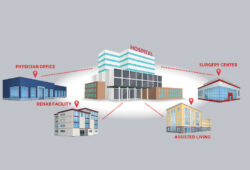Concerns about costs & implementation accompany updated rules on radiology, antibiotic stewardship & anti-coagulants
If it’s true that change is the only constant, the adage is particularly relevant for health systems, as a wave of new and updated requirements roll in for radiology use, antibiotic stewardship and anticoagulant therapy.
The following mandates are coming into play:
- The Centers for Medicare & Medicaid Services (CMS) is moving forward (after many delays) with regulations around the appropriate use of radiology, which will eventually be linked to reimbursement.
- CMS is also mandating antibiotic stewardship measures.
- The Joint Commission has issued new standards surrounding blood thinners.
As beneficial as the mandates could be to patients and providers—potentially improving outcomes and saving money—they still present cost and logistical challenges to facilities, HealthTrust experts explain.

“Hospitals are in a predicament, because they don’t have this easy flow of funds to say, ‘We can do it all, no problem,’” says Luann Culbreth, MEd, MBA, RT, FACHE, former HealthTrust Director of Radiology and Cardiovascular Services, Clinical Operations.
At the same time, leadership buy-in is essential, adds Christopher French, PharmD, Director, Clinical Pharmacy Operations at HealthTrust. “A pitfall to consider is not having executive-level leadership to help drive the changes and understand the implications to the hospital.”
Radiology under scrutiny
The updated CMS radiology regulations, now in a year-long educational and operations testing period, were a long time coming. Beginning in 2014 with the Protecting Access to Medicare Act, the mandate requires referring providers to consult appropriate use criteria (AUC) through a CMS approved qualified clinical decision support mechanism (CDSM) before ordering CT, MR, nuclear medicine or PET exams for outpatients covered by Medicare Part B.
Starting in 2021, payment to the facility and interpreting radiologist will be denied without a correctly documented AUC consultation. The law names eight priority clinical areas, including coronary artery disease, headaches and hips.
“CMS wants to make sure there’s a process in place in radiology, as is the case with other service lines, that an appropriate exam is being ordered and performed,” Culbreth explains. “It’s all definitely associated with cost.”
Continual delays since 2014 in locking in the mandate are due to a lack of understanding by CMS about the complexities of implementing these extra procedures, Culbreth says. For instance, the additional detail required on billing codes to meet regulations is an extra burden on hospital staff and IT infrastructure.
“Sometimes a government agency is trying to do the right thing. But it doesn’t understand all of the nuances of what it would take to implement a quality decision support mechanism and educate the ordering physicians, who really have no stake in the game—they’re just ordering the exam,” she says. “There has been a lot of feedback to CMS from the medical community about the hardships of implementing these systems and the cost.”
HealthTrust member facilities that stand to be impacted most include those that perform a high volume of outpatient radiology exams on Medicare patients, Culbreth adds. Those who wait to implement the necessary measures will risk not being reimbursed by CMS when the testing period ends. “It’s challenging when we have to spend money to make money,” she says.
Antibiotic Stewardship Spotlighted
CMS also issued a final rule requiring all acute-care hospitals participating in Medicare or Medicaid to implement antibiotic stewardship programs as part of infection control efforts. Among other measures, hospitals must assign an infection control officer, document evidence-based use of antibiotics in all departments and services, and demonstrate improvements in proper antibiotic use, such as reductions of antibiotic resistance.

“Antibiotic stewardship has been going on in many hospitals for at least four years, if not longer,” French explains. “The goal is to reduce hospital acquired infections and other infectious diseases, and to also reduce inappropriate use of antimicrobials.”
In order to optimize the use of antibiotics, The Joint Commission has already been measuring hospitals’ efforts to combat antibiotic resistance during triennial accreditation visits, French notes.
Anticoagulant updates
The Joint Commission applied eight new performance metrics in July 2019 to all accredited institutions regarding anticoagulant therapy. With a rise in adverse drug events linked to oral blood thinners, the updated regulations are designed to reverse that trend and improve out, French explains.
Among other requirements, facilities must implement and document evidence-based protocols to manage anticoagulant treatment, including the reversal of such therapy to lower the likelihood of patient harm. Facilities must also educate patients and families about medication and dosing compliance, and potential drug and food interactions linked with severe adverse drug events.
“This is almost like a stewardship of anticoagulant use,” French adds. “There will be a lot more monitoring and tracking of safety events—obviously, trying to reduce those events. Some people were starting to do this over the last few years anyway, but now hospitals are going to be required to have standard protocols.”
For both the anticoagulant and antibiotic stewardship mandates, French advises hospital leaders to take an active role in the transition process. “It’s not only about improved patient care. Downstream costs will be reduced,” he says. “If you don’t engage executive-level leadership to help drive these changes, you’re going to have a hard time effectively implementing the requirements.”
Share Email CMS, Infection Prevention, Joint Commission, Q2 2020, Radiology, Regulations




